Effectiveness of Nanotechnology in Cardiovascular Disease: Proposal
VerifiedAdded on 2022/10/15
|34
|9451
|375
Project
AI Summary
This research proposal investigates the effectiveness of nanotechnology in the prevention, diagnosis, and treatment of cardiovascular diseases. It aims to compare the impact of nanotechnology on patient outcomes, including quality of life and mortality rates, with traditional interventions such as oral medications and invasive surgeries. The study employs a quantitative, retrospective, cross-sectional research design involving surveys of health professionals, particularly cardiologists and heart surgeons, to gather their perspectives on nanotechnology's application. Additionally, it will collect data on mortality rates across different age groups receiving nanotechnology versus open-heart surgery. The research hypothesizes that nanotechnology improves patient health outcomes, mortality rates, and overall quality of life compared to traditional interventions. The proposal includes a comprehensive literature review covering cardiovascular diseases, the need for novel interventions, and an overview of nanotechnology. The methodology section details the research design, data collection methods, data analysis techniques, and ethical considerations. The study's findings are expected to provide insights into current trends in healthcare technology and pave the way for future innovation in cardiovascular treatment.
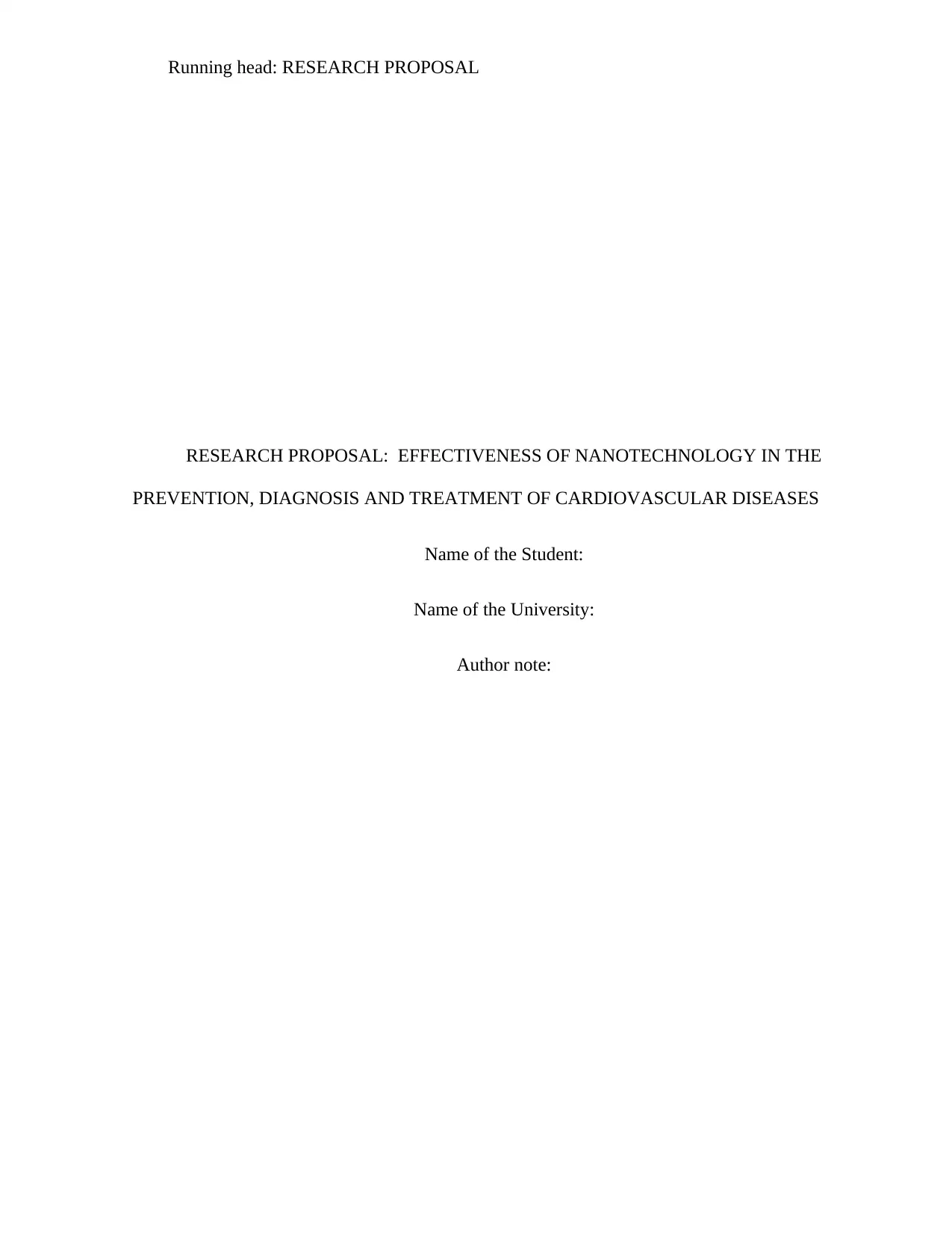
Running head: RESEARCH PROPOSAL
RESEARCH PROPOSAL: EFFECTIVENESS OF NANOTECHNOLOGY IN THE
PREVENTION, DIAGNOSIS AND TREATMENT OF CARDIOVASCULAR DISEASES
Name of the Student:
Name of the University:
Author note:
RESEARCH PROPOSAL: EFFECTIVENESS OF NANOTECHNOLOGY IN THE
PREVENTION, DIAGNOSIS AND TREATMENT OF CARDIOVASCULAR DISEASES
Name of the Student:
Name of the University:
Author note:
Paraphrase This Document
Need a fresh take? Get an instant paraphrase of this document with our AI Paraphraser
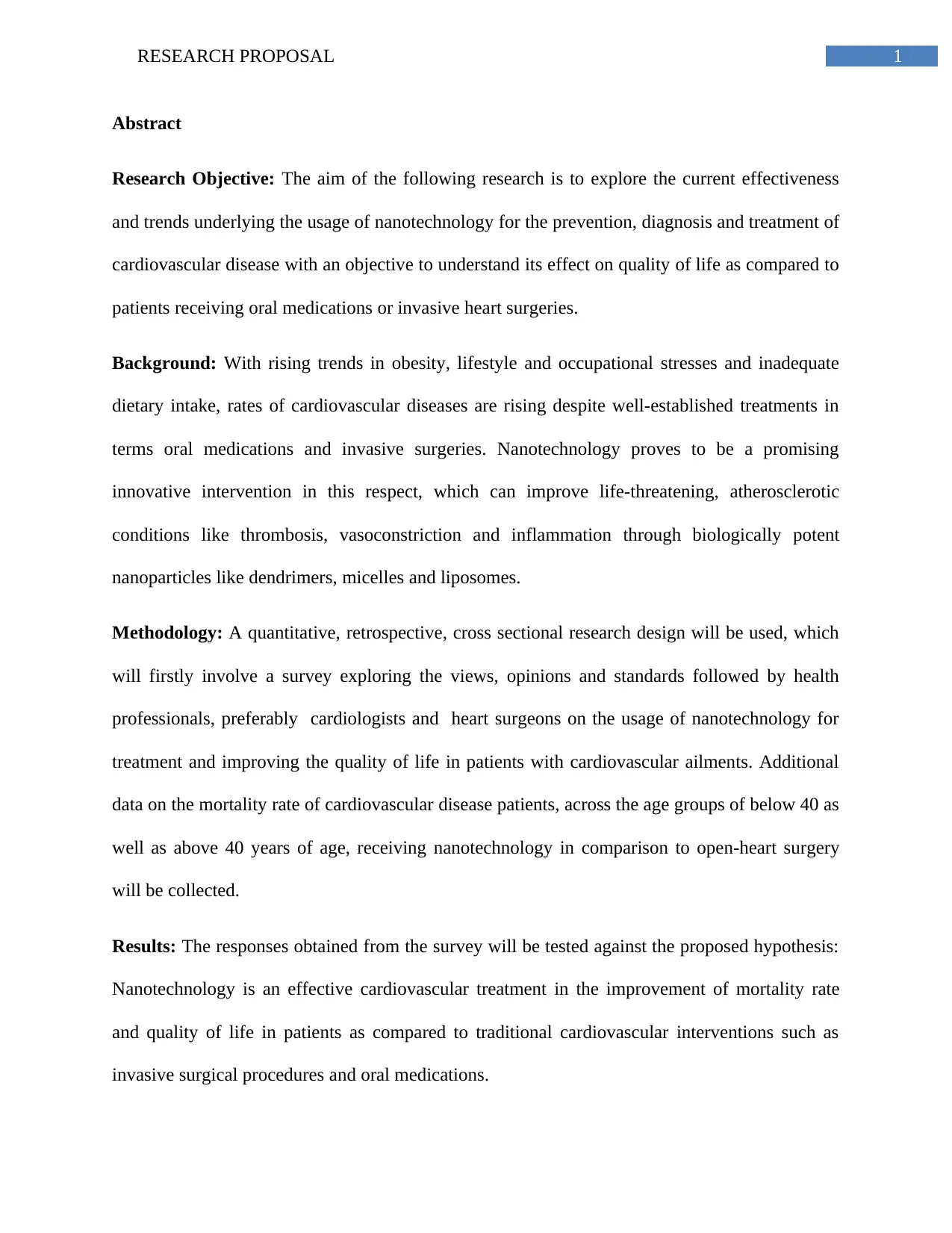
1RESEARCH PROPOSAL
Abstract
Research Objective: The aim of the following research is to explore the current effectiveness
and trends underlying the usage of nanotechnology for the prevention, diagnosis and treatment of
cardiovascular disease with an objective to understand its effect on quality of life as compared to
patients receiving oral medications or invasive heart surgeries.
Background: With rising trends in obesity, lifestyle and occupational stresses and inadequate
dietary intake, rates of cardiovascular diseases are rising despite well-established treatments in
terms oral medications and invasive surgeries. Nanotechnology proves to be a promising
innovative intervention in this respect, which can improve life-threatening, atherosclerotic
conditions like thrombosis, vasoconstriction and inflammation through biologically potent
nanoparticles like dendrimers, micelles and liposomes.
Methodology: A quantitative, retrospective, cross sectional research design will be used, which
will firstly involve a survey exploring the views, opinions and standards followed by health
professionals, preferably cardiologists and heart surgeons on the usage of nanotechnology for
treatment and improving the quality of life in patients with cardiovascular ailments. Additional
data on the mortality rate of cardiovascular disease patients, across the age groups of below 40 as
well as above 40 years of age, receiving nanotechnology in comparison to open-heart surgery
will be collected.
Results: The responses obtained from the survey will be tested against the proposed hypothesis:
Nanotechnology is an effective cardiovascular treatment in the improvement of mortality rate
and quality of life in patients as compared to traditional cardiovascular interventions such as
invasive surgical procedures and oral medications.
Abstract
Research Objective: The aim of the following research is to explore the current effectiveness
and trends underlying the usage of nanotechnology for the prevention, diagnosis and treatment of
cardiovascular disease with an objective to understand its effect on quality of life as compared to
patients receiving oral medications or invasive heart surgeries.
Background: With rising trends in obesity, lifestyle and occupational stresses and inadequate
dietary intake, rates of cardiovascular diseases are rising despite well-established treatments in
terms oral medications and invasive surgeries. Nanotechnology proves to be a promising
innovative intervention in this respect, which can improve life-threatening, atherosclerotic
conditions like thrombosis, vasoconstriction and inflammation through biologically potent
nanoparticles like dendrimers, micelles and liposomes.
Methodology: A quantitative, retrospective, cross sectional research design will be used, which
will firstly involve a survey exploring the views, opinions and standards followed by health
professionals, preferably cardiologists and heart surgeons on the usage of nanotechnology for
treatment and improving the quality of life in patients with cardiovascular ailments. Additional
data on the mortality rate of cardiovascular disease patients, across the age groups of below 40 as
well as above 40 years of age, receiving nanotechnology in comparison to open-heart surgery
will be collected.
Results: The responses obtained from the survey will be tested against the proposed hypothesis:
Nanotechnology is an effective cardiovascular treatment in the improvement of mortality rate
and quality of life in patients as compared to traditional cardiovascular interventions such as
invasive surgical procedures and oral medications.

2RESEARCH PROPOSAL
Conclusion: This study will provide and insights on current trends in healthcare technology and
will pave the way for future innovation in cardiovascular treatment and improved health
outcomes in patients.
Conclusion: This study will provide and insights on current trends in healthcare technology and
will pave the way for future innovation in cardiovascular treatment and improved health
outcomes in patients.
⊘ This is a preview!⊘
Do you want full access?
Subscribe today to unlock all pages.

Trusted by 1+ million students worldwide
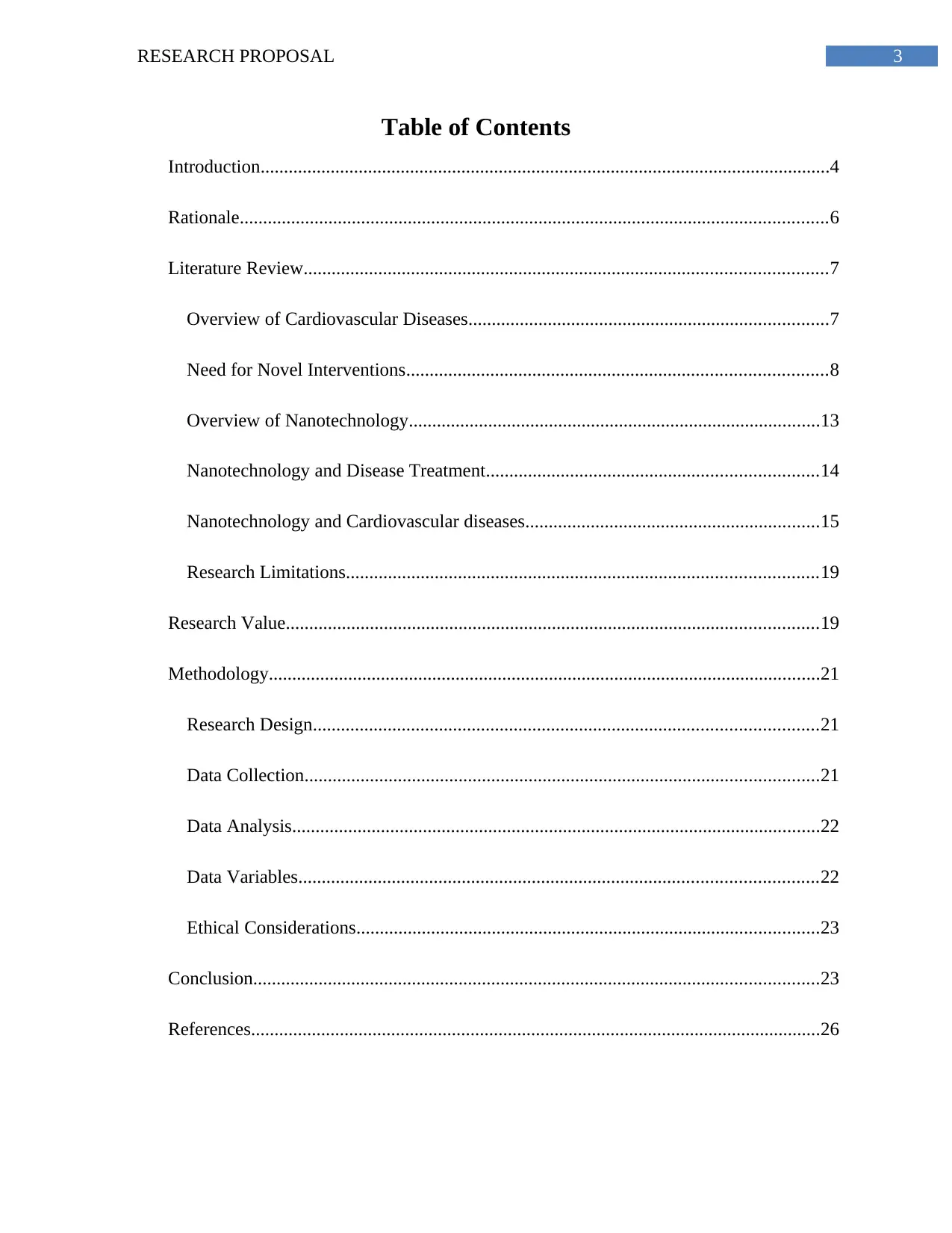
3RESEARCH PROPOSAL
Table of Contents
Introduction..........................................................................................................................4
Rationale..............................................................................................................................6
Literature Review................................................................................................................7
Overview of Cardiovascular Diseases.............................................................................7
Need for Novel Interventions..........................................................................................8
Overview of Nanotechnology........................................................................................13
Nanotechnology and Disease Treatment.......................................................................14
Nanotechnology and Cardiovascular diseases...............................................................15
Research Limitations.....................................................................................................19
Research Value..................................................................................................................19
Methodology......................................................................................................................21
Research Design............................................................................................................21
Data Collection..............................................................................................................21
Data Analysis.................................................................................................................22
Data Variables...............................................................................................................22
Ethical Considerations...................................................................................................23
Conclusion.........................................................................................................................23
References..........................................................................................................................26
Table of Contents
Introduction..........................................................................................................................4
Rationale..............................................................................................................................6
Literature Review................................................................................................................7
Overview of Cardiovascular Diseases.............................................................................7
Need for Novel Interventions..........................................................................................8
Overview of Nanotechnology........................................................................................13
Nanotechnology and Disease Treatment.......................................................................14
Nanotechnology and Cardiovascular diseases...............................................................15
Research Limitations.....................................................................................................19
Research Value..................................................................................................................19
Methodology......................................................................................................................21
Research Design............................................................................................................21
Data Collection..............................................................................................................21
Data Analysis.................................................................................................................22
Data Variables...............................................................................................................22
Ethical Considerations...................................................................................................23
Conclusion.........................................................................................................................23
References..........................................................................................................................26
Paraphrase This Document
Need a fresh take? Get an instant paraphrase of this document with our AI Paraphraser
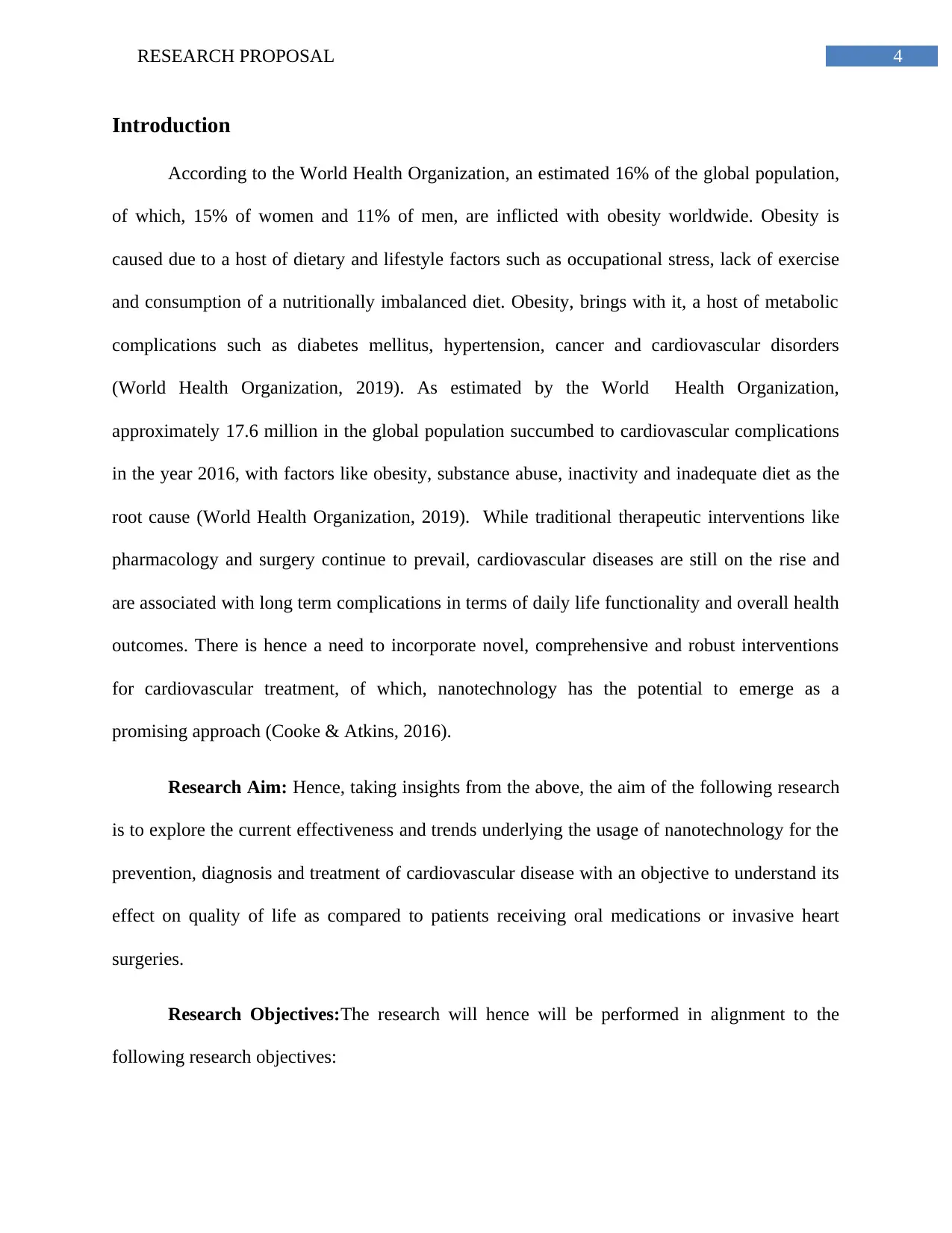
4RESEARCH PROPOSAL
Introduction
According to the World Health Organization, an estimated 16% of the global population,
of which, 15% of women and 11% of men, are inflicted with obesity worldwide. Obesity is
caused due to a host of dietary and lifestyle factors such as occupational stress, lack of exercise
and consumption of a nutritionally imbalanced diet. Obesity, brings with it, a host of metabolic
complications such as diabetes mellitus, hypertension, cancer and cardiovascular disorders
(World Health Organization, 2019). As estimated by the World Health Organization,
approximately 17.6 million in the global population succumbed to cardiovascular complications
in the year 2016, with factors like obesity, substance abuse, inactivity and inadequate diet as the
root cause (World Health Organization, 2019). While traditional therapeutic interventions like
pharmacology and surgery continue to prevail, cardiovascular diseases are still on the rise and
are associated with long term complications in terms of daily life functionality and overall health
outcomes. There is hence a need to incorporate novel, comprehensive and robust interventions
for cardiovascular treatment, of which, nanotechnology has the potential to emerge as a
promising approach (Cooke & Atkins, 2016).
Research Aim: Hence, taking insights from the above, the aim of the following research
is to explore the current effectiveness and trends underlying the usage of nanotechnology for the
prevention, diagnosis and treatment of cardiovascular disease with an objective to understand its
effect on quality of life as compared to patients receiving oral medications or invasive heart
surgeries.
Research Objectives:The research will hence will be performed in alignment to the
following research objectives:
Introduction
According to the World Health Organization, an estimated 16% of the global population,
of which, 15% of women and 11% of men, are inflicted with obesity worldwide. Obesity is
caused due to a host of dietary and lifestyle factors such as occupational stress, lack of exercise
and consumption of a nutritionally imbalanced diet. Obesity, brings with it, a host of metabolic
complications such as diabetes mellitus, hypertension, cancer and cardiovascular disorders
(World Health Organization, 2019). As estimated by the World Health Organization,
approximately 17.6 million in the global population succumbed to cardiovascular complications
in the year 2016, with factors like obesity, substance abuse, inactivity and inadequate diet as the
root cause (World Health Organization, 2019). While traditional therapeutic interventions like
pharmacology and surgery continue to prevail, cardiovascular diseases are still on the rise and
are associated with long term complications in terms of daily life functionality and overall health
outcomes. There is hence a need to incorporate novel, comprehensive and robust interventions
for cardiovascular treatment, of which, nanotechnology has the potential to emerge as a
promising approach (Cooke & Atkins, 2016).
Research Aim: Hence, taking insights from the above, the aim of the following research
is to explore the current effectiveness and trends underlying the usage of nanotechnology for the
prevention, diagnosis and treatment of cardiovascular disease with an objective to understand its
effect on quality of life as compared to patients receiving oral medications or invasive heart
surgeries.
Research Objectives:The research will hence will be performed in alignment to the
following research objectives:

5RESEARCH PROPOSAL
1. To explore the current trends and opinions among health professionals on the
effectiveness of nanotechnology in improving patient health outcomes as compared to
traditional interventions such as oral medications or invasive heart surgeries.
2. To explore the effectiveness of nanotechnology in improving the quality of life in cardiac
patients in comparison to traditional interventions such as oral medications or invasive
heart surgeries.
3. To explore the effectiveness of nanotechnology in improving the mortality rate of cardiac
patients in comparison to patients receiving traditional interventions such as oral
medications or invasive heart surgeries.
Hence, taking insights from the above, the proposed research will be based upon the
following hypothesis:
1. Alternative hypothesis: Nanotechnology is an effective cardiovascular intervention in
terms of improvement of patient’s health outcomes, mortality of life and overall quality
of life as compared to traditional interventions such as oral medications or invasive heart
surgeries.
2. Null hypothesis: Nanotechnology is not an effective cardiovascular intervention in terms
of improvement of patient’s health outcomes, mortality of life and overall quality of life
as compared to traditional interventions such as oral medications or invasive heart
surgeries.
1. To explore the current trends and opinions among health professionals on the
effectiveness of nanotechnology in improving patient health outcomes as compared to
traditional interventions such as oral medications or invasive heart surgeries.
2. To explore the effectiveness of nanotechnology in improving the quality of life in cardiac
patients in comparison to traditional interventions such as oral medications or invasive
heart surgeries.
3. To explore the effectiveness of nanotechnology in improving the mortality rate of cardiac
patients in comparison to patients receiving traditional interventions such as oral
medications or invasive heart surgeries.
Hence, taking insights from the above, the proposed research will be based upon the
following hypothesis:
1. Alternative hypothesis: Nanotechnology is an effective cardiovascular intervention in
terms of improvement of patient’s health outcomes, mortality of life and overall quality
of life as compared to traditional interventions such as oral medications or invasive heart
surgeries.
2. Null hypothesis: Nanotechnology is not an effective cardiovascular intervention in terms
of improvement of patient’s health outcomes, mortality of life and overall quality of life
as compared to traditional interventions such as oral medications or invasive heart
surgeries.
⊘ This is a preview!⊘
Do you want full access?
Subscribe today to unlock all pages.

Trusted by 1+ million students worldwide
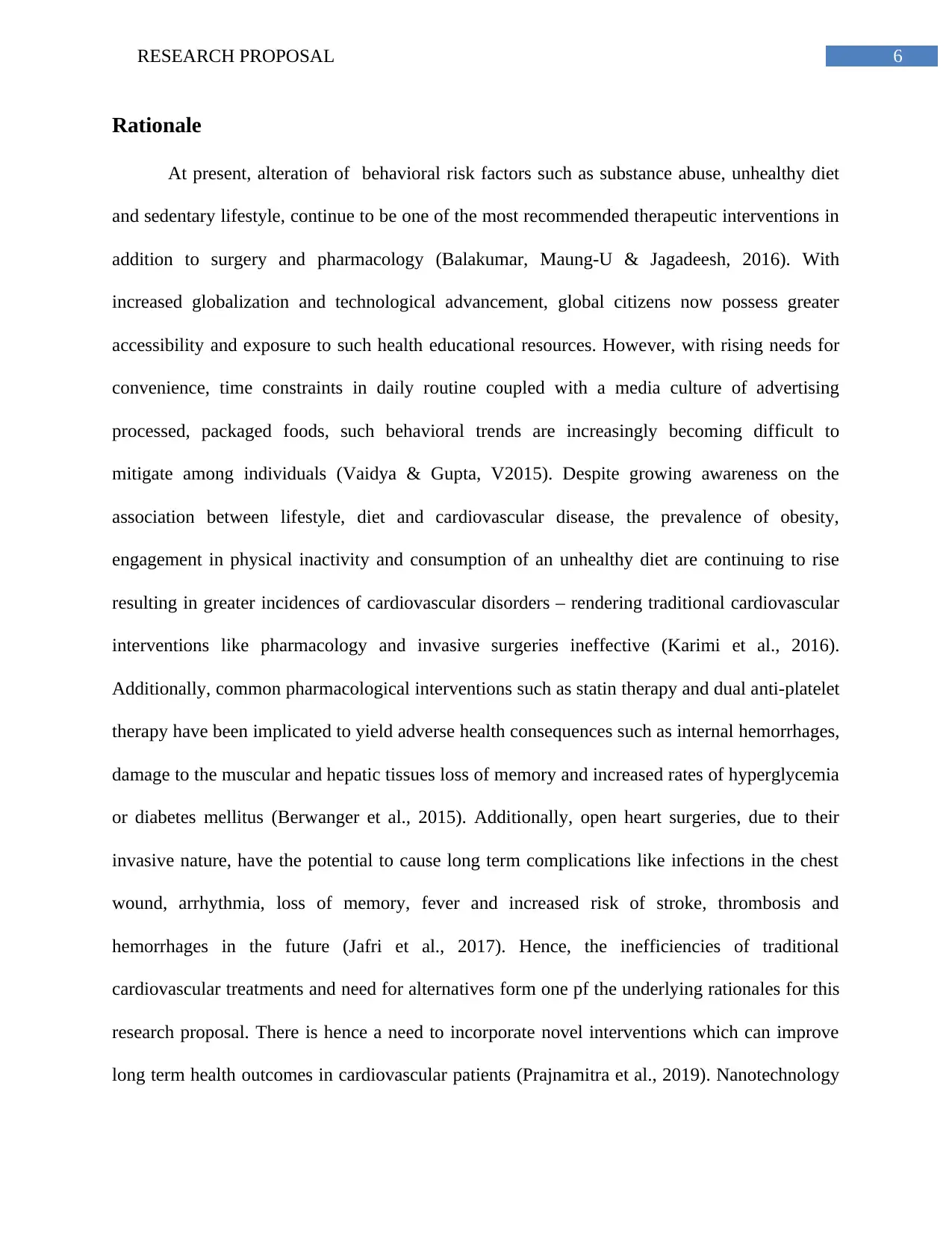
6RESEARCH PROPOSAL
Rationale
At present, alteration of behavioral risk factors such as substance abuse, unhealthy diet
and sedentary lifestyle, continue to be one of the most recommended therapeutic interventions in
addition to surgery and pharmacology (Balakumar, Maung-U & Jagadeesh, 2016). With
increased globalization and technological advancement, global citizens now possess greater
accessibility and exposure to such health educational resources. However, with rising needs for
convenience, time constraints in daily routine coupled with a media culture of advertising
processed, packaged foods, such behavioral trends are increasingly becoming difficult to
mitigate among individuals (Vaidya & Gupta, V2015). Despite growing awareness on the
association between lifestyle, diet and cardiovascular disease, the prevalence of obesity,
engagement in physical inactivity and consumption of an unhealthy diet are continuing to rise
resulting in greater incidences of cardiovascular disorders – rendering traditional cardiovascular
interventions like pharmacology and invasive surgeries ineffective (Karimi et al., 2016).
Additionally, common pharmacological interventions such as statin therapy and dual anti-platelet
therapy have been implicated to yield adverse health consequences such as internal hemorrhages,
damage to the muscular and hepatic tissues loss of memory and increased rates of hyperglycemia
or diabetes mellitus (Berwanger et al., 2015). Additionally, open heart surgeries, due to their
invasive nature, have the potential to cause long term complications like infections in the chest
wound, arrhythmia, loss of memory, fever and increased risk of stroke, thrombosis and
hemorrhages in the future (Jafri et al., 2017). Hence, the inefficiencies of traditional
cardiovascular treatments and need for alternatives form one pf the underlying rationales for this
research proposal. There is hence a need to incorporate novel interventions which can improve
long term health outcomes in cardiovascular patients (Prajnamitra et al., 2019). Nanotechnology
Rationale
At present, alteration of behavioral risk factors such as substance abuse, unhealthy diet
and sedentary lifestyle, continue to be one of the most recommended therapeutic interventions in
addition to surgery and pharmacology (Balakumar, Maung-U & Jagadeesh, 2016). With
increased globalization and technological advancement, global citizens now possess greater
accessibility and exposure to such health educational resources. However, with rising needs for
convenience, time constraints in daily routine coupled with a media culture of advertising
processed, packaged foods, such behavioral trends are increasingly becoming difficult to
mitigate among individuals (Vaidya & Gupta, V2015). Despite growing awareness on the
association between lifestyle, diet and cardiovascular disease, the prevalence of obesity,
engagement in physical inactivity and consumption of an unhealthy diet are continuing to rise
resulting in greater incidences of cardiovascular disorders – rendering traditional cardiovascular
interventions like pharmacology and invasive surgeries ineffective (Karimi et al., 2016).
Additionally, common pharmacological interventions such as statin therapy and dual anti-platelet
therapy have been implicated to yield adverse health consequences such as internal hemorrhages,
damage to the muscular and hepatic tissues loss of memory and increased rates of hyperglycemia
or diabetes mellitus (Berwanger et al., 2015). Additionally, open heart surgeries, due to their
invasive nature, have the potential to cause long term complications like infections in the chest
wound, arrhythmia, loss of memory, fever and increased risk of stroke, thrombosis and
hemorrhages in the future (Jafri et al., 2017). Hence, the inefficiencies of traditional
cardiovascular treatments and need for alternatives form one pf the underlying rationales for this
research proposal. There is hence a need to incorporate novel interventions which can improve
long term health outcomes in cardiovascular patients (Prajnamitra et al., 2019). Nanotechnology
Paraphrase This Document
Need a fresh take? Get an instant paraphrase of this document with our AI Paraphraser
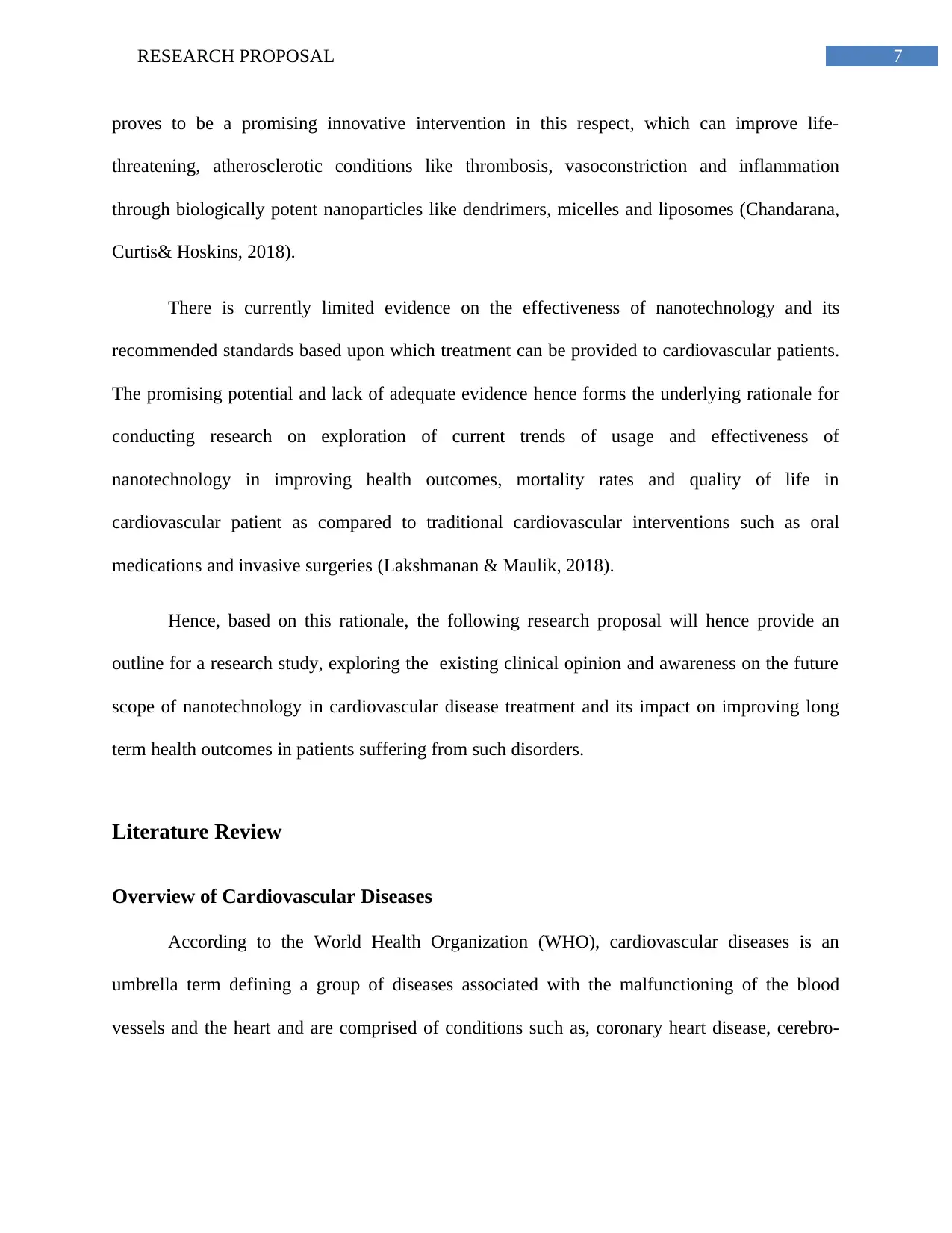
7RESEARCH PROPOSAL
proves to be a promising innovative intervention in this respect, which can improve life-
threatening, atherosclerotic conditions like thrombosis, vasoconstriction and inflammation
through biologically potent nanoparticles like dendrimers, micelles and liposomes (Chandarana,
Curtis& Hoskins, 2018).
There is currently limited evidence on the effectiveness of nanotechnology and its
recommended standards based upon which treatment can be provided to cardiovascular patients.
The promising potential and lack of adequate evidence hence forms the underlying rationale for
conducting research on exploration of current trends of usage and effectiveness of
nanotechnology in improving health outcomes, mortality rates and quality of life in
cardiovascular patient as compared to traditional cardiovascular interventions such as oral
medications and invasive surgeries (Lakshmanan & Maulik, 2018).
Hence, based on this rationale, the following research proposal will hence provide an
outline for a research study, exploring the existing clinical opinion and awareness on the future
scope of nanotechnology in cardiovascular disease treatment and its impact on improving long
term health outcomes in patients suffering from such disorders.
Literature Review
Overview of Cardiovascular Diseases
According to the World Health Organization (WHO), cardiovascular diseases is an
umbrella term defining a group of diseases associated with the malfunctioning of the blood
vessels and the heart and are comprised of conditions such as, coronary heart disease, cerebro-
proves to be a promising innovative intervention in this respect, which can improve life-
threatening, atherosclerotic conditions like thrombosis, vasoconstriction and inflammation
through biologically potent nanoparticles like dendrimers, micelles and liposomes (Chandarana,
Curtis& Hoskins, 2018).
There is currently limited evidence on the effectiveness of nanotechnology and its
recommended standards based upon which treatment can be provided to cardiovascular patients.
The promising potential and lack of adequate evidence hence forms the underlying rationale for
conducting research on exploration of current trends of usage and effectiveness of
nanotechnology in improving health outcomes, mortality rates and quality of life in
cardiovascular patient as compared to traditional cardiovascular interventions such as oral
medications and invasive surgeries (Lakshmanan & Maulik, 2018).
Hence, based on this rationale, the following research proposal will hence provide an
outline for a research study, exploring the existing clinical opinion and awareness on the future
scope of nanotechnology in cardiovascular disease treatment and its impact on improving long
term health outcomes in patients suffering from such disorders.
Literature Review
Overview of Cardiovascular Diseases
According to the World Health Organization (WHO), cardiovascular diseases is an
umbrella term defining a group of diseases associated with the malfunctioning of the blood
vessels and the heart and are comprised of conditions such as, coronary heart disease, cerebro-

8RESEARCH PROPOSAL
vascular heart disease, peripheral heart disease, rheumatic heart disease, congenital heart disease,
pulmonary embolism and deep vein thrombosis (World Health Organization, 2019).
Myocardial infarction and cerebro-vascular accidents are life threatening cardiovascular
conditions that are caused due to underlying blockages across blood vessels resulting in
disruption of nutritious oxygen and nutrient rich blood to essential organs, such as the brain and
the heart, which can exert fatal consequences (Anderson& Morrow, 2017). One of the most
prevalent reasons contributing to such conditions is the deposition of fatty streaks in the
endothelium or internals walls lining the major blood vessels circulating to the brain, heart and
associated organs. Such conditions further progress into formation of large blood clots which
disrupt blood circulation and often cause a rupture across the affected area of the blood vessel,
known as a stroke, resulting in internal hemorrhages (Heusch&Gersh, 2016).
As estimated by the World Health Organization (WHO), cardiovascular diseases (CVD)
comprise of one of the leading causes of death as the highest contributor of mortality in the
global population. In the year 2016, it was estimated that CVDs were the cause of death for a
total of 17.9 million in the world, which comprises of 31% worldwide deaths. Out of this
percentage, stroke and heart attacks are considered to be contributors of approximately 85% of
deaths due to CVD in the world (World Health Organization, 2019).
Need for Novel Interventions
According to the World Health Organization (WHO), several behavioral aspects are some
of the key risk factors underlying the occurrence of CVDs. These include obesity and overweight
anthropometric conditions, consumption of processed foods or a diet rich in salt, saturated fats
and sugar and substance use such as smoking and intake of alcohol. Reducing or regulating the
vascular heart disease, peripheral heart disease, rheumatic heart disease, congenital heart disease,
pulmonary embolism and deep vein thrombosis (World Health Organization, 2019).
Myocardial infarction and cerebro-vascular accidents are life threatening cardiovascular
conditions that are caused due to underlying blockages across blood vessels resulting in
disruption of nutritious oxygen and nutrient rich blood to essential organs, such as the brain and
the heart, which can exert fatal consequences (Anderson& Morrow, 2017). One of the most
prevalent reasons contributing to such conditions is the deposition of fatty streaks in the
endothelium or internals walls lining the major blood vessels circulating to the brain, heart and
associated organs. Such conditions further progress into formation of large blood clots which
disrupt blood circulation and often cause a rupture across the affected area of the blood vessel,
known as a stroke, resulting in internal hemorrhages (Heusch&Gersh, 2016).
As estimated by the World Health Organization (WHO), cardiovascular diseases (CVD)
comprise of one of the leading causes of death as the highest contributor of mortality in the
global population. In the year 2016, it was estimated that CVDs were the cause of death for a
total of 17.9 million in the world, which comprises of 31% worldwide deaths. Out of this
percentage, stroke and heart attacks are considered to be contributors of approximately 85% of
deaths due to CVD in the world (World Health Organization, 2019).
Need for Novel Interventions
According to the World Health Organization (WHO), several behavioral aspects are some
of the key risk factors underlying the occurrence of CVDs. These include obesity and overweight
anthropometric conditions, consumption of processed foods or a diet rich in salt, saturated fats
and sugar and substance use such as smoking and intake of alcohol. Reducing or regulating the
⊘ This is a preview!⊘
Do you want full access?
Subscribe today to unlock all pages.

Trusted by 1+ million students worldwide

9RESEARCH PROPOSAL
adherence to such risk factors is one of the most prevalent ways of reducing the risk of CVDs
across individuals (World Health Organization, 2019). However, despite considerable awareness
concerning the need to avoid such behaviors, trends in the consumption of unhealthy diets and
lack of exercise continue to aggravate hence resulting in the need to administer more robust
interventions for the treatment and management of CVDs (Hulsegge et al., 2016).
At present, as researched by Elmariah et al., (2018), the current therapeutic interventions
underlying the treatment and management of CVDs, in addition to behavioral change, includes
pharmacological interventions and surgical methods such as invasive heart surgeries. Behavioral
risk factors continue to remain difficult to reverse due to occupational stresses and increased
marketing and advertisement of processed foods. Additionally, pharmacological interventions
also possess uncertainties in case of efficiency, as evidenced by low response of individuals who
have already encountered an episode of acute myocardial infarction, towards clopidogrel – a
medication administered for the reduction of CVDs and strokes especially after incidences of
heart attacks or surgical placements such as coronary stents.
Alternative interventions for CVDs include invasive surgeries such as open heart or
coronary bypass grafting methods, which may not be tolerated by some individuals (especially
those with multiple metabolicsymptoms like diabetes and hypertension) and result in long
termcomplications in the form of infections in the chest wounds, recurrent fever and perceptions
of pain, damage to additional organs such as renal or pulmonary failure, loss of memory and
blood or relapse of cardiovascular symptoms such as clot formation and possibilities of stroke
and myocardial infarction (Hassan et al., 2018).Such adversities associated with traditional
interventions of CVD treatment hence necessitates the need to administer alternative therapeutic
technologies which are not only minimally invasive and hence, devoid of the complications
adherence to such risk factors is one of the most prevalent ways of reducing the risk of CVDs
across individuals (World Health Organization, 2019). However, despite considerable awareness
concerning the need to avoid such behaviors, trends in the consumption of unhealthy diets and
lack of exercise continue to aggravate hence resulting in the need to administer more robust
interventions for the treatment and management of CVDs (Hulsegge et al., 2016).
At present, as researched by Elmariah et al., (2018), the current therapeutic interventions
underlying the treatment and management of CVDs, in addition to behavioral change, includes
pharmacological interventions and surgical methods such as invasive heart surgeries. Behavioral
risk factors continue to remain difficult to reverse due to occupational stresses and increased
marketing and advertisement of processed foods. Additionally, pharmacological interventions
also possess uncertainties in case of efficiency, as evidenced by low response of individuals who
have already encountered an episode of acute myocardial infarction, towards clopidogrel – a
medication administered for the reduction of CVDs and strokes especially after incidences of
heart attacks or surgical placements such as coronary stents.
Alternative interventions for CVDs include invasive surgeries such as open heart or
coronary bypass grafting methods, which may not be tolerated by some individuals (especially
those with multiple metabolicsymptoms like diabetes and hypertension) and result in long
termcomplications in the form of infections in the chest wounds, recurrent fever and perceptions
of pain, damage to additional organs such as renal or pulmonary failure, loss of memory and
blood or relapse of cardiovascular symptoms such as clot formation and possibilities of stroke
and myocardial infarction (Hassan et al., 2018).Such adversities associated with traditional
interventions of CVD treatment hence necessitates the need to administer alternative therapeutic
technologies which are not only minimally invasive and hence, devoid of the complications
Paraphrase This Document
Need a fresh take? Get an instant paraphrase of this document with our AI Paraphraser

10RESEARCH PROPOSAL
associated with invasive surgeries, but will also be of optimum potency for the alleviation of
symptoms associated with CVDs (Sharma et al., 2016).
One of the most prevalent conditions which are associated with high mortality due to
CVDs, is ischemia and myocardial infarction. An underlying CVD pathology which is
responsible for these conditions is atherosclerosis. Atherosclerosis is caused due to accumulation
excessive deposition and accumulation of cholesterol, macrophage cells, cholesterol and fat in
the endothelial lining of blood vessels resulting in their hardening to form plaques in the future.
Such atherosclerotic depositions progress to further severe complications such as narrowed blood
vessel, blockages and disturbances in normal blood circulation, rupturing of the affected blood
vessels and hence a condition of ischemia (Lesnefsky et al., 2017). Anincident of ischemia
occurring in the cardiovascular system results in deprivation of nutrient rich blood to the heart
further leading to loss of oxygen, malfunctioning of the surrounding cardiac muscles and hence
an episode of heart attack or myocardial infarction. Compensatory mechanisms occur in the body
as a response, known as reperfusion, and are associated with an increase in the permeability of
arterioles and capillaries resulting increased rates of diffusion and filtration in the endothelial
tissues. However, ironically, such mechanisms are often followed by increased oxidative damage
resultant cell apoptosis due to the high production of reactive oxygen species in comparison to
nitric oxide by endothelial cells which are activated to exert the above reperfusion mechanisms.
Such a CVD condition is known as ischemia/ reperfusion injury (Ibanez et al., 2015).
Cardiomyocytes are the cells forming the muscular tissues of the heart and hence are the
major components responsible for the contraction required to initiate blood circulation. An
episode of myocardial infarction results in a loss of approximately 25% of these cardiac muscle
cells. Mature cardiomyocytes possess reduced ability to proliferate resulting in a permanent loss
associated with invasive surgeries, but will also be of optimum potency for the alleviation of
symptoms associated with CVDs (Sharma et al., 2016).
One of the most prevalent conditions which are associated with high mortality due to
CVDs, is ischemia and myocardial infarction. An underlying CVD pathology which is
responsible for these conditions is atherosclerosis. Atherosclerosis is caused due to accumulation
excessive deposition and accumulation of cholesterol, macrophage cells, cholesterol and fat in
the endothelial lining of blood vessels resulting in their hardening to form plaques in the future.
Such atherosclerotic depositions progress to further severe complications such as narrowed blood
vessel, blockages and disturbances in normal blood circulation, rupturing of the affected blood
vessels and hence a condition of ischemia (Lesnefsky et al., 2017). Anincident of ischemia
occurring in the cardiovascular system results in deprivation of nutrient rich blood to the heart
further leading to loss of oxygen, malfunctioning of the surrounding cardiac muscles and hence
an episode of heart attack or myocardial infarction. Compensatory mechanisms occur in the body
as a response, known as reperfusion, and are associated with an increase in the permeability of
arterioles and capillaries resulting increased rates of diffusion and filtration in the endothelial
tissues. However, ironically, such mechanisms are often followed by increased oxidative damage
resultant cell apoptosis due to the high production of reactive oxygen species in comparison to
nitric oxide by endothelial cells which are activated to exert the above reperfusion mechanisms.
Such a CVD condition is known as ischemia/ reperfusion injury (Ibanez et al., 2015).
Cardiomyocytes are the cells forming the muscular tissues of the heart and hence are the
major components responsible for the contraction required to initiate blood circulation. An
episode of myocardial infarction results in a loss of approximately 25% of these cardiac muscle
cells. Mature cardiomyocytes possess reduced ability to proliferate resulting in a permanent loss
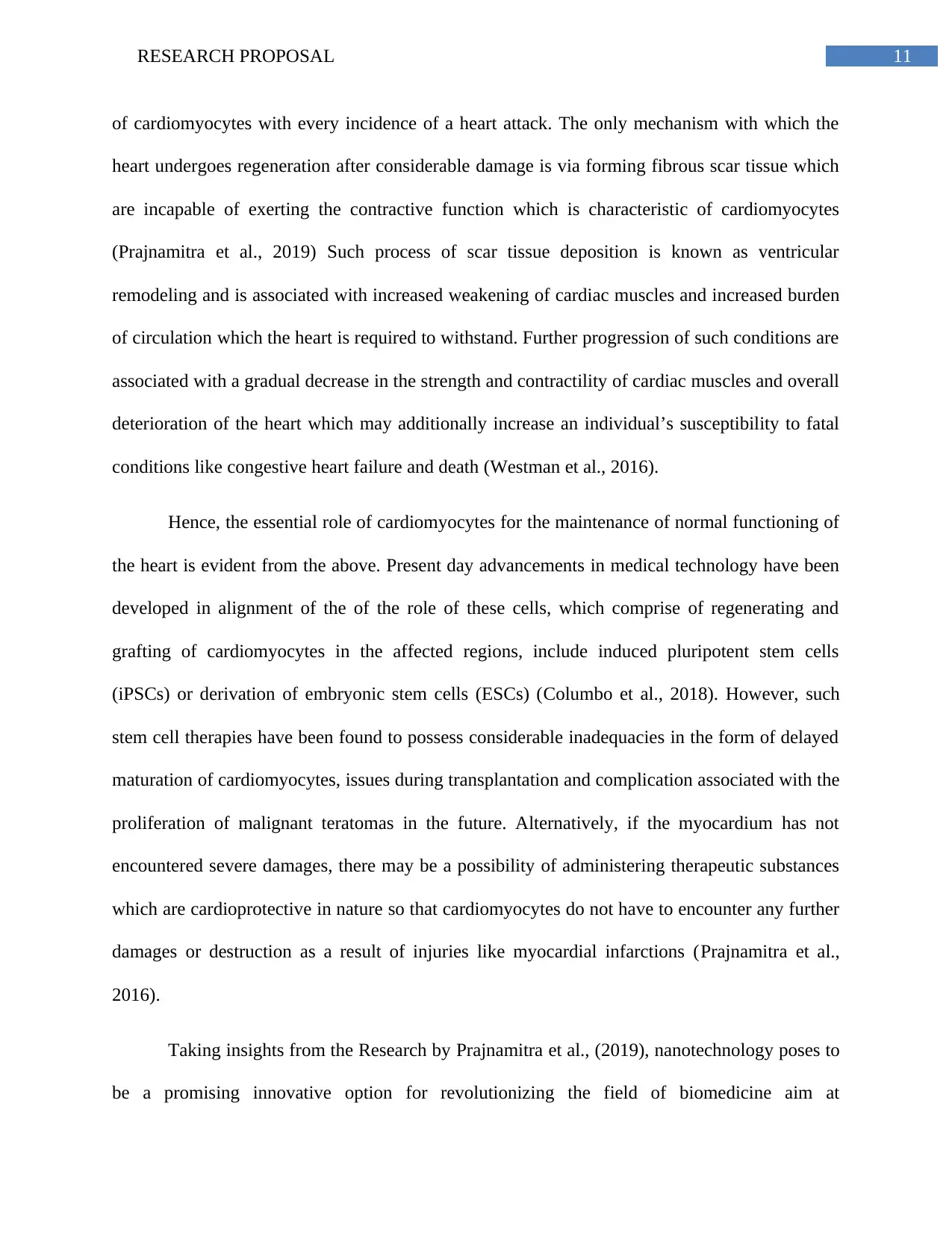
11RESEARCH PROPOSAL
of cardiomyocytes with every incidence of a heart attack. The only mechanism with which the
heart undergoes regeneration after considerable damage is via forming fibrous scar tissue which
are incapable of exerting the contractive function which is characteristic of cardiomyocytes
(Prajnamitra et al., 2019) Such process of scar tissue deposition is known as ventricular
remodeling and is associated with increased weakening of cardiac muscles and increased burden
of circulation which the heart is required to withstand. Further progression of such conditions are
associated with a gradual decrease in the strength and contractility of cardiac muscles and overall
deterioration of the heart which may additionally increase an individual’s susceptibility to fatal
conditions like congestive heart failure and death (Westman et al., 2016).
Hence, the essential role of cardiomyocytes for the maintenance of normal functioning of
the heart is evident from the above. Present day advancements in medical technology have been
developed in alignment of the of the role of these cells, which comprise of regenerating and
grafting of cardiomyocytes in the affected regions, include induced pluripotent stem cells
(iPSCs) or derivation of embryonic stem cells (ESCs) (Columbo et al., 2018). However, such
stem cell therapies have been found to possess considerable inadequacies in the form of delayed
maturation of cardiomyocytes, issues during transplantation and complication associated with the
proliferation of malignant teratomas in the future. Alternatively, if the myocardium has not
encountered severe damages, there may be a possibility of administering therapeutic substances
which are cardioprotective in nature so that cardiomyocytes do not have to encounter any further
damages or destruction as a result of injuries like myocardial infarctions (Prajnamitra et al.,
2016).
Taking insights from the Research by Prajnamitra et al., (2019), nanotechnology poses to
be a promising innovative option for revolutionizing the field of biomedicine aim at
of cardiomyocytes with every incidence of a heart attack. The only mechanism with which the
heart undergoes regeneration after considerable damage is via forming fibrous scar tissue which
are incapable of exerting the contractive function which is characteristic of cardiomyocytes
(Prajnamitra et al., 2019) Such process of scar tissue deposition is known as ventricular
remodeling and is associated with increased weakening of cardiac muscles and increased burden
of circulation which the heart is required to withstand. Further progression of such conditions are
associated with a gradual decrease in the strength and contractility of cardiac muscles and overall
deterioration of the heart which may additionally increase an individual’s susceptibility to fatal
conditions like congestive heart failure and death (Westman et al., 2016).
Hence, the essential role of cardiomyocytes for the maintenance of normal functioning of
the heart is evident from the above. Present day advancements in medical technology have been
developed in alignment of the of the role of these cells, which comprise of regenerating and
grafting of cardiomyocytes in the affected regions, include induced pluripotent stem cells
(iPSCs) or derivation of embryonic stem cells (ESCs) (Columbo et al., 2018). However, such
stem cell therapies have been found to possess considerable inadequacies in the form of delayed
maturation of cardiomyocytes, issues during transplantation and complication associated with the
proliferation of malignant teratomas in the future. Alternatively, if the myocardium has not
encountered severe damages, there may be a possibility of administering therapeutic substances
which are cardioprotective in nature so that cardiomyocytes do not have to encounter any further
damages or destruction as a result of injuries like myocardial infarctions (Prajnamitra et al.,
2016).
Taking insights from the Research by Prajnamitra et al., (2019), nanotechnology poses to
be a promising innovative option for revolutionizing the field of biomedicine aim at
⊘ This is a preview!⊘
Do you want full access?
Subscribe today to unlock all pages.

Trusted by 1+ million students worldwide
1 out of 34
Related Documents
Your All-in-One AI-Powered Toolkit for Academic Success.
+13062052269
info@desklib.com
Available 24*7 on WhatsApp / Email
![[object Object]](/_next/static/media/star-bottom.7253800d.svg)
Unlock your academic potential
Copyright © 2020–2025 A2Z Services. All Rights Reserved. Developed and managed by ZUCOL.





